Phase Diagram PDF

| Title | Phase Diagram |
|---|---|
| Author | Limzy Dee |
| Course | Chemistry |
| Institution | Kaduna State University |
| Pages | 4 |
| File Size | 439.9 KB |
| File Type | |
| Total Downloads | 78 |
| Total Views | 141 |
Summary
Phase Diagram...
Description
Name Period Changes of State, Vapor Pressure, & Phase Diagrams Chemistry -
Date
Generic Phase Diagram Sublimation is the phase change as a substance changes from a solid to a gas without passing through the intermediate state of a liquid. Deposition is the phase change as a substance changes from a gas to a solid without passing through the intermediate state of a liquid. TRIPLE POINT - The temperature and pressure at which the solid, liquid, and gas phases exist simultaneously. CRITICAL POINT - The temperature above which a substance will always be a gas regardless of the pressure. NOTE: The solid phase is more dense than the liquid phase. The line between the solid and gas phases is the equilibrium of solid and gas phases at that specific pressure and temperature, i.e. a curve of all the deposition/sublimation points. The line between the solid and liquid phases is the equilibrium of solid and liquid phases at that specific pressure and temperature, i.e. a curve of all the freezing/melting points. The line between the liquid and gas phases is the equilibrium of liquid and gas phases at that specific pressure and temperature, i.e. a curve of all the vaporization/condensation points. Melting Point (Freezing Point) - The temperature at which the solid and liquid phases of a substance are in equilibrium at atmospheric pressure. Normal Melting Point (Freezing Point) - The temperature at which the solid changes to a liquid at Standard Pressure (1.00 atm = 760 mmHg = 760 torr = 101.325 kPa) Boiling Point (Condensation Point) - The temperature at which the vapor pressure of a liquid is equal to the pressure on the liquid. Normal Boiling Point (Condensation Point) - The temperature at which the vapor pressure of a liquid is equal to Standard Pressure (1.00 atm = 760 mmHg = 760 torr = 101.325 kPa)
Phase Diagram for Water For water, the liquid phase is more dense than the solid phase due to hydrogen bonding.
Vapor Pressure If you put any liquid in a sealed vessel and wait long enough, (b) the liquid will come into equiilibrium with its vapor, and a constant (steady; dependent only y of the temperature) equilibrium vapor pressure will be b established.
Normal Boiling Point - The ttemperature at which the vapor pressure of a liquid is equal to Standard Pressure (1.00 atm = 760 mmHg = 760 0 torr = 101.325 kPa)
APH PART B – V APOR PRESSURE GRA
Use the graph at right to answer the following f questions : 1. What is the vapor pressure of CH HCl 3 at 50 C? 2. What is the boiling point of H 2 O when the external pressure is 30 kPa? 3. What is the normal boiling point of CCl4? 4. Which substance has the weakest IMF? 5. What does each VP curve represent?
Phase Diagram 1 Use the phase diagram for water at riight to answer the following questions: 1. What is the state of water at 2 atm m and 50
t temperature 2. What phase change will occur if the is lowered from 80 C to -5 C at 11 atm?
3. You have ice at -10 C and 1 atm. What could you do in order cause the ice to suublime?
Phase Diagram 2 Refer to the phase diagram at right when answering the questions on this worksheet: 1. What is the normal freezing point of this substance? 2. What is the normal boiling point of this substance? 3. What is the normal melting point of this substance? 4. If I had a quantity of this substance at a pressure of 1.25 atm and a temperature of 3000 C and lowered the pressure to 0.25 atm, what phase transition(s) would occur? 5 At what temperature do the gas and liquid phases become indistinguishable from each other? 6. If I had a quantity of this substance at a pressure of 0.75 atm and a temperature of -1000 C, what phase change(s) would occur if I increased the temperature to 6000 C? At what temperature(s) would they occur?
Phase Diagram 3 For each of the questions on this worksheet, refer to the phase diagram for mysterious compound X: 1. What is the critical temperature of compound X?
2. If you were to have a bottle containing compound in your closet, what phase would it most likely be in?
3. At what temperature and pressure will all three phases coexist?
4. If I have a bottle of compound X at a pressure of 45 atm and temperature of 1000 C, what will happen if I raise the temperature to 400 0 C?
5. Why can’t compound X be boiled at a temperature of 2000 C?
6. If I wanted to, could I drink compound X?
Name:_____________________________________Period____Date__________________________ Chemistry I - Phase Diagrams Water & CO2 Use the diagrams below to answer the following questions: Phase Diagram for Water
(Not to Scale)
Phase Diagram for Carbon Dioxide
1. What does Point O in both diagrams above represents? And what can you tell me about the phase or phases of matter at those pressures and temperatures?
2. What is the significance of line OF?
3. What is the significance of line OG?
4. What is the significance of line OE?
5. Using the diagrams above indicate the proper temperature or pressure for the following points. a. Normal melting point oC for water______ g. Normal boiling point foro C for water______ b. Triple point temp for water _______
h. triple point pressure for water _______
c. Triple point temp for CO2 _______
i. triple point pressure for CO2 _______
d. Critical pressure for water _______
j. critical temp for water _______
e. Critical pressure for CO2 _______
k. critical temp for CO2 _______
f. Normal sublimation temperature for CO2 _________ 6. Refer to the phase diagram for water. What changes in temperature, pressure, and physical state would be necessary to go from point D to point C?
7. Refer to the phase diagram for CO2 . What changes in temperature, pressure, and physical state would be necessary to go from point B to point D?...
Similar Free PDFs

PHASE DIAGRAM (DIAGRAM FASA
- 14 Pages

Phase Diagram
- 4 Pages

Phase Rule
- 21 Pages

Phase 1 and phase 2 reactions
- 8 Pages

TRAFO 1 PHASE DAN 3 PHASE
- 13 Pages

Diagram ishikawy
- 9 Pages

Diagram muscle
- 6 Pages

Corr TPHill Phase Photochimique
- 4 Pages
Popular Institutions
- Tinajero National High School - Annex
- Politeknik Caltex Riau
- Yokohama City University
- SGT University
- University of Al-Qadisiyah
- Divine Word College of Vigan
- Techniek College Rotterdam
- Universidade de Santiago
- Universiti Teknologi MARA Cawangan Johor Kampus Pasir Gudang
- Poltekkes Kemenkes Yogyakarta
- Baguio City National High School
- Colegio san marcos
- preparatoria uno
- Centro de Bachillerato Tecnológico Industrial y de Servicios No. 107
- Dalian Maritime University
- Quang Trung Secondary School
- Colegio Tecnológico en Informática
- Corporación Regional de Educación Superior
- Grupo CEDVA
- Dar Al Uloom University
- Centro de Estudios Preuniversitarios de la Universidad Nacional de Ingeniería
- 上智大学
- Aakash International School, Nuna Majara
- San Felipe Neri Catholic School
- Kang Chiao International School - New Taipei City
- Misamis Occidental National High School
- Institución Educativa Escuela Normal Juan Ladrilleros
- Kolehiyo ng Pantukan
- Batanes State College
- Instituto Continental
- Sekolah Menengah Kejuruan Kesehatan Kaltara (Tarakan)
- Colegio de La Inmaculada Concepcion - Cebu







